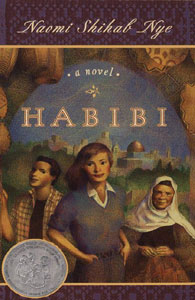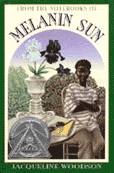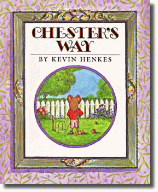

Inclusive Literature
 Nye,
Naomi Shihab. 1999. Habibi. New York: Simon Pulse. ISBN 0689825234.
Nye,
Naomi Shihab. 1999. Habibi. New York: Simon Pulse. ISBN 0689825234.
Habibi is a story about fourteen year old Liyana and her family. Her father is Palestinian and came to the United States to study medicine and to escape the violence in his country. Of course, once in the United States, he falls in love with and marries an American woman and decides to stay. He longs to return to his country. The decision becomes final, he accepts a job at a hospital in Jerusalem and he moves his wife and two children there so they can learn about their family and their heritage.
Once in Jerusalem, Liyana and her brother realize they have a lot to learn about the culture and the events that are occurring at the time. When her father’s family arrives at the hotel to greet them, Liyana and Rafik, her brother, experience a little culture shock, then become curious about the customs and ways of the people.
She experiences several difficulties throughout the story, including hatred and racism. Liyana’s grandmother, Sitti, wants to teach her how to live in the traditional way, but Liyana resists, then she begins to accept things for the way they are.
Liyana attends school in the Armenian quarter and is the only American child there. She begins to explore her surroundings, and as a result meets a young Jewish boy. She finds that she and Omer are two of a kind: two who only want peace.
This story is laced with cultural markers throughout. Nye’s description of the children’s olive-colored skin, like their father’s, related to the Palestinian heritage. The customs, food, clothing, and language are visited frequently. One vivid description of Sitti, Liyana’s grandmother and her wild trilling to express her joy of the family’s arrival, helps add to the authenticity of the story. One can only imagine this elderly woman emitting her high pitched trill right in the hotel room! Nye includes mention of the muezzin giving the call to prayer. Traditional foods are included as well.
Nye offers an extensive knowledge of the traditions and customs of the Palestinians and the Jews.
This would be a fabulous story for readers in the intermediate grades, as well as junior high and high school.

Woodson, Jacqueline. 1995. From the notebooks of Melanin Sun. New York: Scholastic. ISBN 0590458817.
Melanin Sun is a young teenage boy who has a wonderful relationship with his single mother. Until, that is, she reveals that she is a lesbian. Up until then, Melanin Sun, or “Mel,” has had more of a deep friendship with his mom, rather than a typical mother/son relationship. They shared everything in life. Mel is trying to get a grip on adolescence: getting up the nerve to call a certain girl, pimples, and just hanging out with the guys. He is insightful and loves to write in his notebooks, which the other guys sometimes say is “faggy.” Mel lets it roll, though. He knows he isn’t gay. But when his mother begins asking him about homosexuality, he thinks that SHE thinks he is! That’s when she informs him that it is her that is gay. He battles this detail of his mother’s life. In addition to this news, he has to deal with the fact that his mother’s chosen partner is white. Once his friends find out, Mel finds himself pretty much alone. After much anger, depression, and loneliness, he begins to re-accept his mother and he begins to see his mother’s partner as a human being. In addition, his one true friend comes around and accepts this part of Mel’s life.
This story deals with many issues all rolled up into one book! Race, preconceived notions about homosexuality and the repercussions of unaccepting “friends” and neighbors, are things the main character must deal with, in addition to typical teenage emotions.
Woodson creates an upfront interest in this book with such a unique title. She then presents a wonderful description of how Melanin Sun got his name at birth, much to the objection of the doctor and nurse who were present. He was named for his dark, ebony skin. When the nurse asks his mother whether she knows what “melanin” is, his mother responds in such a matter of fact manner that she does, indeed, know EXACTLY what it is and that is why she chose the name.
Woodson’s handling of the issue of homosexuality in a book for young people is done remarkably well. The two female characters are presented as they should be, as normal, healthy, loving human beings. The story is a perfect example of how love can conquer whatever issues arise in our lives.
This is a great, easy-to-read book for readers in grades six and up. Henkes, Kevin.
1988. Chester's way. New York: Greenwillow. ISBN 0688076084.
Henkes, Kevin.
1988. Chester's way. New York: Greenwillow. ISBN 0688076084.
This wonderful story had to be included here, even though the characters are mice, not human beings! The female character in this book is one of the strongest little (mouse) girls in the world! Two best friends, Chester and Wilson, do everything together. They are basically inseparable. They do everything in the exact, same way. The two of them live happily in their predictable little world until Lily moves in! She thinks outside the box and does things in her own individual way. While Chester and Wilson cut neat, straightly-trimmed triangular sandwiches, Lily finds flower-shaped cookie cutters for hers. She wears crazy disguises and the two (mouse) boys don't really want much to do with Lily since she can't do things their way. They decide to just stay away from her for as long as possible. One day, Chester and Wilson run into some neighborhood bullies and who comes to their rescue? Lily, of course!! The three finally become friends and accept each other for what they are.
Lily is such a strong female character that she has merited a book of her
own. It, too, is a must-read! Girls and boys alike will love this independent
girl who can break through just about any gender barrier! The book is
geared towards readers in grades 1-3.
 Shyer,
Marlene Fanta. 1988. Welcome home, Jellybean. New York: Aladdin. ISBN
0689712138.
Shyer,
Marlene Fanta. 1988. Welcome home, Jellybean. New York: Aladdin. ISBN
0689712138.